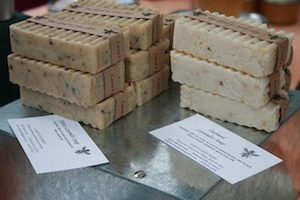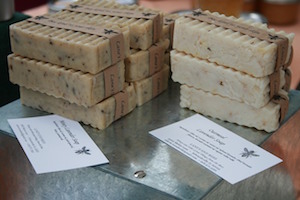
“Here are two recipes for soap. One is for a two pound batch and one for a one pound batch. The equipment and procedures are the same for both, except for the size of the mold. I have soap making equipment set aside in one place to make it easy to gather when I get ready to make a batch or two.”
Equipment needed:
Stainless steel or enamel pot
Wooden or stainless steel spoons (two will do and use large ones)
Plastic pitchers (two, in half gallon size) Get these at dollar store or yard sale
Cheap silicone or plastic spatulas (2)
Plastic containers for weighing oils, butters etc. I use old sour cream containers
Scale that weighs in ounces
stainless steel thermometers (2)
Stick blender (optional)

Molds
There are all sorts of things that can be used as soap molds. I have two kinds I prefer. I have a small, 10″ x 3″x 3″ for a one pound batch. It is a silicone mold and I bought it on Amazon. I also use a plastic container that had 5 oz of salad greens from the grocery store. It also works for a one pound batch. For a two pound batch I use an 8″x 8″ or an 8″ x 10″ Tupperware container I bought at a yard sale.
I like the flexible molds because it makes it easier to remove the soap.
To prepare the molds, I spray with cooking oil or grease with shortening.
Put on the gloves
Measure the lye in one plastic pitcher. All measurements are by weight. Be sure to calculate the weight of the container.
Measure the water in the other plastic pitcher.
This is the part where you have to be particularly careful. I always do this outside, as fumes from lye are dangerous.
Pour the water into the lye, stirring to dissolve. Stand back and don’t breath in the fumes. Once the lye is dissolved, set aside to cool. This mixture is HOT so it may take a few hours, or you may set the pitcher into cool water to hurry the process along. Put the lid on the pitcher to guard against an accidental spill.
You are going to cool the lye to around 95 degrees.
Melt the oils together in the pot and maintain at around 95 degrees.
When both oil and lye are at 95 degrees, slowly pour the lye into the oils and mix either with a stick blender or a spoon. The blender is much faster.
If you use the blender, you will fairly quickly see “trace” which is the mixture thickening. It is at this point you would add any colorings or ingredients such as oatmeal.
Next, add essential oils and blend. Some oils will cause the mixture to begin thickening rapidly. Pour your soap into the mold while it is still the consistency of pudding.
Set it aside in a warm place and leave for 24 to 48 hours. At this point you should be able to turn the soap out onto clean cardboard, butcher paper or something similar for cutting.
Cut into bars and set aside for a couple of weeks to cure. The longer they sit, the harder they will be. But go ahead and try one after a week or so.
So that is the procedure. Now for a couple of recipes. You may use additives or not as you please with both recipes. For the Bastile soap, I have not included any additives. But I will list options.
Bastile Soap – 2 lbs.
Castor oil -2oz
Coconut oil (76 degree) 8 oz.
Olive oil -22 oz.
Sodium Hydroxide (lye) 4.4 oz.
Water 10.5 oz
Follow above directions.
Options for additives, ground oatmeal, ground chamomile flowers about 2 tbs.
Essential oil 1 oz.
This next recipe is one I created.
Palm Kernel oil-.80 oz
Olive oil-4.8 oz
Shea Butter-5.6 oz
Coconut oil (76 degree) 4.8 oz
Water-6.08 oz
Lye-2.25 oz
Peppermint essential oil-.25 oz
Rosemary essential oil-.25 oz
Coloring if desired.
Follow above directions
You can find a variety of soap colorings from suppliers of soap making equipment. I use oxide colorings.
“These are two recipes I really like, but I make others and keep experimenting. In the future, I shall include very basic recipes for when we might not have the luxury of experimenting with other ingredients.”
